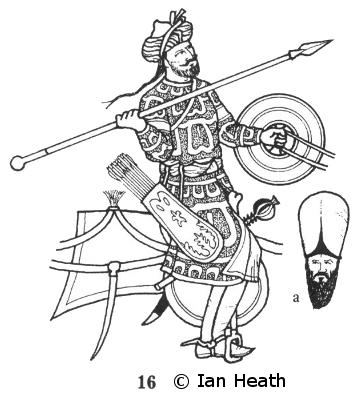
Register a SNAP EBT card with Amazon
MAMLUK 1366
An extract from Armies of the Middle Ages, Volume 2by Ian Heath

 |
| [Based on folio 99, Nihayat Al-su’l wa Al-Umniyya fi Ta’lim A’mal Al-Furusiyya by Muhammad ibn ’Isa ibn Isma’il al-Hanafi al-Aqsara’i] |
16. MAMLUK 1366
As can be seen from this figure (from a Furusiyya ms.), Mamluk costume of this period remained basically unchanged from that shown in Armies and Enemies of the Crusades, comprising a cap, tunic, topcoat (qaba) and khuff boots. The coat was still usually the yellow, red or white ‘Tartar’ coat, which persisted throughout the period under review, though towards the end of the Circassian era different types of coat, such as the short-sleeved sallari in particular, and the maluta coat with its large collar, were recognised as characteristically Mamluk. (According to William Popper, enlisted free troopers in the Mamluk army did not wear such topcoats; their belts for which see below were thus visible, this allegedly being ‘one of the distinguishing marks’ of their lower rank. It therefore comes as no surprise to find that the bestowal of a sallari to the non-mamluk chief of the black arquebusiers in 1498 led to a revolt by the Royal Mamluks.)
The cap could be one of a variety of types, notably the sharbush (abolished under the Circassians; see figure 41 in Armies and Enemies of the Crusades); the kalautah (a yellow or red cap worn with a kerchief wrapped round it as here, later of somewhat greater dimensions); the taqiyya (a busby-like hat narrower at the bottom than the top and sometimes divided horizontally into 2 colours, often black above and green below; see 16a); and lastly the zamt (worn by figure 20), a red woollen hat considered so typical of Mamluk dress by the late-15th century that, together with the maluta coat, it was required to be worn by Mamluks for recognition purposes following the Ottoman conquest in 1517.
Boots, occasionally laced, were of yellow or black Bulgarian leather in winter and white leather in summer.
Similarly, written sources tell us that in winter outer garments were of coloured and decorated wool or silk, but in summer were plain white. However, although the ms. from which this figure is taken mainly shows white (i.e. summer) boots being worn, the heavily embroidered coats (with muqallab flap crossing the chest diagonally in either direction) are depicted in a variety of rich colours including dark and light blue, red, pink, green and tan (yellow?), therefore presumably portraying winter coats. Hems and cuffs are coloured gold in the ms. while linings and undershirts are either white or some plain, contrasting colour. The tiraz armbands are invariably gold, and we know that by the beginning of the 15th century they were usually of gold brocade or embroidered black silk, sometimes bearing decorative motifs, inscriptions or even the sultan’s or an amir’s name, but otherwise plain. Caps are shown yellow and light brown in the ms., while turbans are invariably white, coloured turbans tending to be used by the Mamluks to distinguish non-Moslems (notably blue for Christians and yellow for Jews). Hair is worn long in a pigtail, younger Mamluks being clean shaven while older men wore beard and moustache.
A belt (hisaya, previously mintaqa) of decorated precious metal roundels, studded with precious stones in the case of high-ranking amirs of 100, completed a Mamluk amir’s costume, ordinary soldiers instead wearing the band, a belt comprising of a coloured sash. The sword was suspended from this belt at the left, while at the right hung the saulaq, a bag of black Bulgarian leather.
Arms depicted in this ms. comprise 2 types of lance (one about 9 feet long, the other about 5½ feet with, usually, a spherical ferrule), slightly curved sword, bow, shield (both the convex hide daraqa and the wooden or iron turs, held by arm-straps and a central grip behind the boss), and iron or steel mace (dabbus), worn under the right knee and stirrup leather. The lance (rumh) remained a popular weapon amongst the Mamluks - in fact perhaps more popular than the bow with some and training in its use underwent considerable change and development throughout this period. We read, for instance, that the way it was held in battle was different by the mid-15th century to what it had been at the end of the 14th century, perhaps indicating that it was couched underarm by the former date since we know it was wielded overarm at the latter. Ibn lyas records that the lance was either entirely of steel, or of wood with a steel blade.
Although the composite bow prevailed amongst Mamluk horsemen, an archery manual dating (probably) to c. 1368 contains in addition a section on the use of a crossbow from horseback. The type of crossbow to be used was the qaws ar-rikab (‘stirrup crossbow’), used in conjunction with a belt (jabbadh) and double-hooked claw (khattaf). The belt was worn across the shoulder with the claw at the right side; to reload, the rider had to take the reins in his left hand and the bow in his right, set the string in the claw-hooks, bend forward until his right foot could locate in the crossbow-stirrup, and then stand up in his stirrups until the string caught on the firing nut. All in all this exercise would seem to have required rather more physical dexterity than most people possess! This source also mentions the use of a horn clip over the nut ‘to prevent the bolts from falling out’, a particularly useful device for a mounted crossbowman; Payne-Gallwey mentions such clips as first appearing in the 16th century, but clearly they were in use considerably earlier.